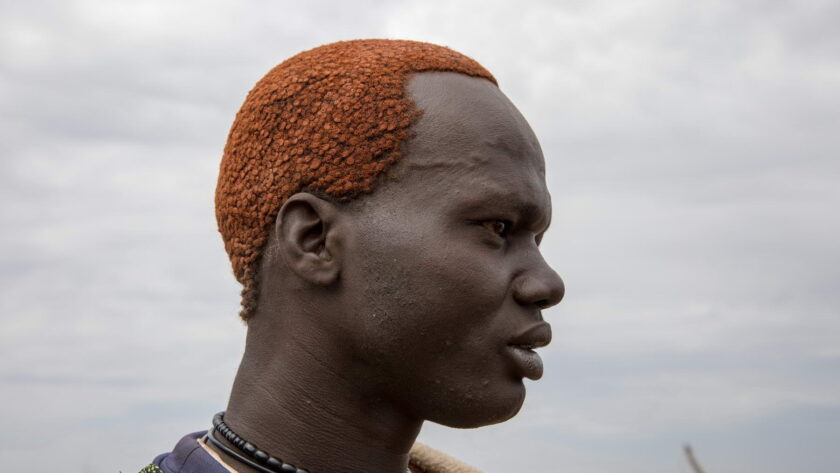At first glance, the Mundari tribe of South Sudan is instantly unforgettable. The women sport brilliant orange hair buns, while both genders coat their skin in an ashen gray powder. But their unique looks are more than meets the eye. The substances they use to achieve these stirring styles are shockingly unexpected—and perhaps even off-putting to Western sensibilities.
Yet, these unusual techniques carry profound meaning for the Mundari people. Their distinctive aesthetic is deeply intertwined with their spiritual beliefs, livelihoods, and cultural identity. For the Mundari, physical appearance is far from just surface-level beauty or fashion.
The tribe’s captivating style speaks to a people with an intricate bond to their environment and cattle. Their traditional practices may seem curious to outsiders, but reveal an indigenous people sticking resolutely to their ancestry. While facing modern threats, the Mundari’s visual individualism persists as a compelling marker of their heritage and a window into their little-known world.
The full story behind the Mundari’s aesthetic choices is an illuminating look at human culture, invention, and what we adorn ourselves with for deeper meaning. Their style’s blunt impact invites examination of not just beauty standards, but how our exterior appearances connect us to our values, environments, and sense of identity.

The Beautiful Silver Skin Of The Mundari Tribe
The ashen gray complexion that makes the Mundari people so recognizable comes from an ingenious body paint made from cattle dung ash. Both men and women in the tribe rub this chalky, powdered pigment directly into their skin to coat their bodies in grey.
To produce this decorative ash, the Mundari first burn dried cow dung into charcoal. This charcoal is then ground down using stones into a fine talcum-like powder. The ash powder is mixed with water to form a paste that can be comfortably applied to the skin.
During application, women predominantly paint their faces, necks, and calves grey. The men cover their chests, shoulders, and backs more extensively with swirling ashen patterns. This graphic body art contrasts with their short black dreadlocks dyed orange with cow urine.

Beyond just cosmetic appeal, the grey dung paint serves functional purposes. The ash acts as a cleansing agent, absorbing dirt and oil on the skin. It also provides protection from the drying effects of the sun and repels insects drawn to sweat in the sweltering climate. The light powdery coating has a cooling effect as it gently reflects sunlight.
Culturally, the white-grey hue holds deep symbolic meaning for the Mundari. The ash connects them to their beloved cattle, which supply this decorative paint ingredient through their dung. The shade evokes the sacred image of oxen and represents the strength and vitality of the cattle flowing into the people when applied.
Grey also signals youth, innocence, and the ancestral spirits who bless the Mundari, in their spiritual cosmology. Wearing this cow dung body paint demonstrates the Mundari’s interdependence with cattle and the natural world. The practice ties them physically and spiritually to the gifts of the land and livestock at the heart of their way of life.
For the Mundari, body ornamentation through ash painting goes far beyond decoration. The weathered grey finish crafted from cattle waste visually encapsulates their identity, heritage, and devotion to the animals they depend on for survival.

The Laborious Process of Mundari Women’s Orange Ochre Hairstyle
The unique hairstyle of Mundari women featuring orange-dyed clay-coated buns is central to their cultural identity. When a Mundari girl reaches puberty around age 12-13, her hair is ritually shaved off to mark her transition into womanhood. Once her hair grows out long enough several months later, it is twisted, sectioned, and shaped into a large round bun or topknot on the crown of her head. This hairstyle is called a “sheisa” in the Mundari language.
Creating the sheisa bun is an elaborate process that can take 4-6 hours. The woman’s natural hair is divided into multiple slim sections. These locks are individually rolled or braided in a spiral pattern to form a dense, rounded bun, often 4-6 inches in diameter.
To coat and color this bun, women mix orange ochre powder gathered from local clay deposits with clarified butter or cattle fat, creating a thick paste. This orange pigment paste is liberally applied over every inch of the sheisa, giving it a vivid burnt orange color as it dries.
The oily ochre mixture also helps solidify and preserve the bun, while deterring insects. A larger, taller sheisa indicates greater beauty, social status, and respect in Mundari society. It shows a woman’s maturity and readiness for marriage.
About once a week, women re-apply the orange ochre paint to maintain vibrancy. They may also add ornaments such as feathers, beads, or goat hair to embellish over time. The ochre’s orange hue holds symbolic meaning, representing fertility, health, and the female nurturing role.

How Mundari Men Use Cow Urine To Dye Hair Orange
Male initiates of the Mundari tribe take a remarkably different approach to achieve their signature orange locks. As boys, they too ritually shave their heads around adolescence to mark their coming of age. After several months, men allow their hair to regrow out into short cropped afros or sectioned into dreadlocks.
To dye their hair a vibrant orange, Mundari men collect urine from cows that have been feasting solely on purple-hued sudd grass. This urine is boiled down over a fire until it reduces to a thick, concentrated orange paste, rich in ammonia.
While the smell is overpowering, the men vigorously massage this cow urine paste into their hair, drying it thoroughly to achieve an eye-catching burnt orange color. The ammonia acts as a natural hair dye, undergoing oxidization and a chemical reaction with the hair protein keratin to impart the vivid hue.
Since the orange color only lasts 2-4 weeks before fading, Mundari men routinely reapply the urine hair dye to maintain this cultural marker of identity. The striking orange tone demonstrates virility, bravery, and strength to protect cattle herds. Risking ridicule, some achieve more elaborate dyed patterns in their dreadlocks.
By using cattle urine, Mundari men display their deep reverence for their livestock and a symbolic harnessing of the animal’s life force. The practice ties them spiritually back to the cattle so central to Mundari beliefs and livelihoods through a graphic display of interconnectedness.

In Conclusion:
For the Mundari people of South Sudan, physical appearance goes far beyond superficial beauty standards. Their use of cow urine dyed orange hair and ash-grayed skin encapsulates a people with an unseverable spiritual connection to cattle and the land.
While shocking to Western sensibilities, these unusual beauty practices stem from the Mundari’s deep-rooted identity as cattle herders. Their reliance on local natural resources and ingenuity speaks to an indigenous people determined to honor their ancestry in an ever-modernizing world.
Yet the Mundari’s aesthetic uniqueness tells just part of their intriguing story. It provides a visible window into a marginalized culture’s beliefs, creativity, and resilience. As pressures mount against their way of life, the Mundari’s captivating looks endure as a symbol of cultural pride and human imagination’s marvelous diversity.

Ultimately, the tribe’s dramatic self-presentation forces an examination of our own assumptions. Their sometimes difficult customs urge us to look past surface perceptions to understand what purposeful meaning people attach to altering their physical forms across cultures. For the marginalized Mundari, the choice to proudly wear symbols of their livelihoods and convictions is a striking demonstration of identity.





